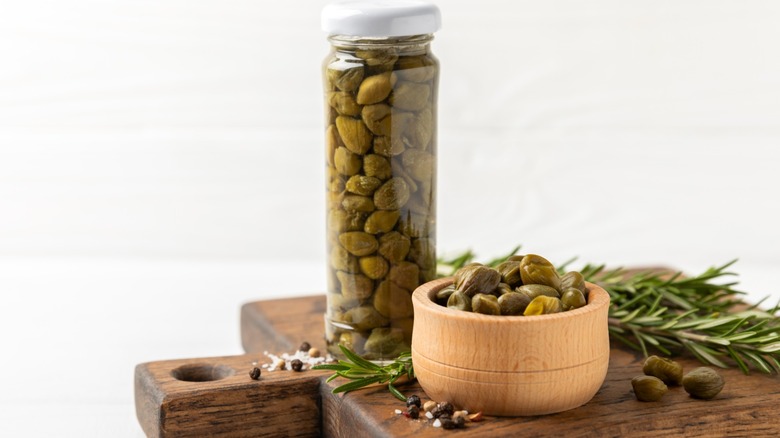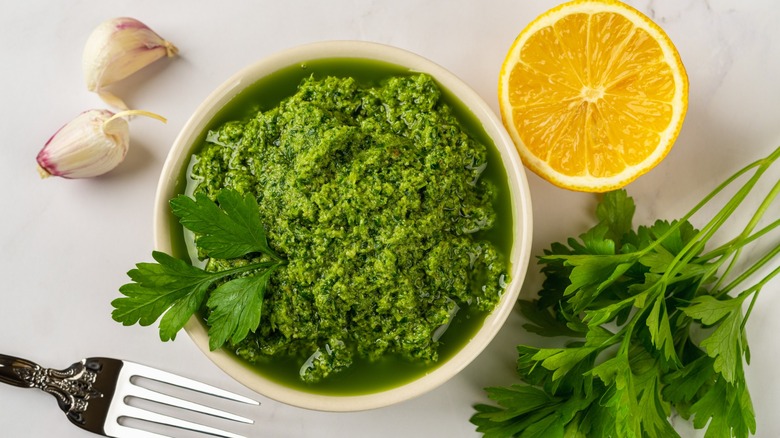Rachael Ray's Secret Ingredient For Nut-Free Pesto
Who doesn't love a good, fresh, authentically-made pesto? If you have a nut allergy, you might've just raised your hand in protest. Pesto is a wonderfully herbaceous and remarkably simple creation — it only features a handful of ingredients. However, one of those key ingredients is pine nuts, much to the chagrin of the millions of Americans with a nut allergy. However, if you happen to have a nut allergy but you still don't want to miss out on the chance to try a delicious pesto caprese panini, Rachael Ray has an answer for you.
Pine nuts have an oily, buttery texture and a mild sweetness, so their elimination from a pesto recipe leaves the overall dish a little more lacking than it ought to be. If you're allergic to pine nuts only, then you could add walnuts in their place (at a much lower cost, by the way). But if you're looking for a completely nut-free option, Rachael Ray suggests something a little more out of left-field. On her website she shared that for her, the addition of capers to a pesto recipe is the secret to making a standout pesto sans pine nuts. Though the elements of texture and taste vary from pine nuts, thereby making quite a different form of pesto, the capers still work with the rest of the ingredients to make an interesting and imminently flavorful sauce.
A jar of capers is the ace up your sleeve
Capers, while certainly not similar to the subtle taste of pine nuts, will bring an added complexity to your pesto. The tiny green morsels, which are nothing more than immature flower buds from the caper bush that are dried and subsequently pickled or otherwise cured, have an acidic and tangy taste with the slightest hint of a lemony flavor. If you were to pick a comparison for them, green olives would be a decent option — however, their flavor is much more concentrated than that of green olives, which have a less sharp taste overall.
Capers will not only add a salty, acidic punch to your pesto, but they will also add a textural boost to the overall product. Capers are somewhat firm, meaning their addition to pesto (whether you use a food processor or the traditional mortar and pestle) is about more than just their taste. If you can find capers preserved in olive oil, they can also lend an oily element to the pesto — a decent replacement for the oils and fats you'd lose from the pine nuts' absence. Not only this, but the oil will help to preserve your pesto, especially if you use olive oil to keep pesto from turning brown.
Don't stop at pesto
Even if you don't use capers, there are other nut-free pesto recipes out there, including simply making a pesto as you normally might, just without the addition of pine nuts. But why draw the line at only making pesto when there are a ton of other green herbal nut-free sauces out there for you to explore? And even better yet, Rachael Ray comes through with a couple of suggestions to get you started on that path.
In initially entertaining the idea of nut-free pesto, Ray likens the altered product to a salsa verde. And while pesto (even without nuts) and salsa verde are two completely distinct sauces, she's right to point the latter out as a good nut-free option to those with dietary restrictions. The tomatillos, poblano peppers, limes, and loads of garlic create a zesty, herbal concoction with a spicy kick from the peppers, and can be an excellent option if you want to deviate from pesto.
As well, you could opt for a chimichurri. Though chimichurri and pesto have different flavors and uses, it's yet another intensely fresh herbal sauce that can really shine with your summertime grilling. The presence of citrus in the sauce makes it even more lively — and best of all, it's also completely nut-free. So whatever sauce you end up choosing for your cooking needs, you can rest assured that there's an option for your dietary restrictions.


